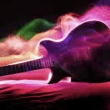I like to think of music as a means for communication. To further this metaphor, various types of music can be though of as languages with many dialects. Some genres are closely related (like English from Maine and English with a southern drawl) or as disparate as Russian and Chinese.
Learning the jazz language can also be the most difficult lesson to
learn, especially if you grew up with rock or classical music. Jazz has a dialect all its own. Sure, jazz uses the same notes, rhythms,
instruments, etc. as other styles, but the use of those elements is
drastically different. Of course you can't learn the language overnight, or even in a few weeks, but there are some things that can help along the way.
The first thing to do is to listen to jazz as much as you can. You can study books and sheet music and practice by yourself in your room
all you want, but you'll never be able to speak it clearly unless you
listen to other people's playing. It's the same way babies learn to
speak. Listen to CDs, tapes, a jazz radio station (if you're lucky enough to have one in your area). Listen to as many types of jazz as you can as well (Big Band, Bebop, Cool, Modal, the list goes on). This is learning by osmosis. Do it as much as you can. The next step is in the "swing."
Note: For the purpose of learning to improvise, which is what jazz is really all about, the elements of jazz in this column come largely from the bebop tradition. I believe that if you start learning jazz by understanding and playing bebop, all other styles of jazz will come easier.
One thing that makes jazz sound different from other types of
music is that it swings. So what is swing? Some teachers have tried to describe it in rhythmic terms, like "lazy 8th-notes." I think swing is more an internal physical and mental process. If you've ever looked at a score of jazz music, it may say "swing" up at the tempo marking, but there's nothing in the notation that looks like swing. There is an assumption on the part of the composer that the players know how to swing.
Something that helped me learn to swing was to always tap my foot on beats 2 and 4. These are typically where the drummer would play the high hat in a tune. In classical and rock music there is an emphasis on beats 1 and 3, and 2 and 4 are considered weak beats. By tapping on 2 and 4, you can physically aid yourself in swinging, especially when playing music that has a lot of syncopation and off-beat rhythms.
Thinking more about the weak beats can make your playing more
relaxed and keep you in the groove, or "in the pocket" in jazz lingo.
While there isn't always a real emphasis on 2 and 4 (one TWO three FOUR) in the music, by keeping the thought of 2 and 4 in your head you can free yourself from the tyranny of beat one. This will also help your phrasing later on. A good way to practice this is to tap on 2 and 4 when you're listening to jazz. You can also do a comparison test. Tap on 1 and 3 to a jazz tune and see if it feels funny. Try tapping on 2 and 4 to a rock tune. It can actually be difficult to do because it will feel very unnatural. It is not what you're used to, and that's exactly the point.
Sean T. Gill is a 4th year undergraduate at the University of Wisconsin-Milwaukee, Wisconsin Conservatory of Music, majoring in jazz and has played guitar for eight years.
He performs in university ensembles, works on various recording projects, and teaches privately.
He also works for Hal Leonard Publishing as an arranger on various guitar projects.
